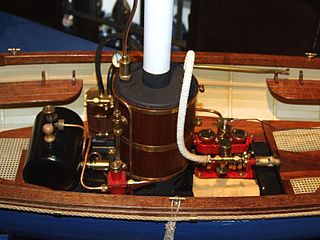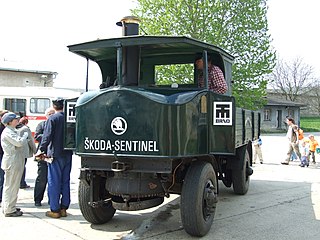A geared steam locomotive is a type of steam locomotive which uses gearing, usually reduction gearing, in the drivetrain, as opposed to the common directly driven design.

Sentinel Waggon Works Ltd was a British company based in Shrewsbury, Shropshire that made steam-powered lorries, railway locomotives, and later, diesel engined lorries, buses and locomotives.

The Lancashire and Yorkshire Railway Class 5 were 2-4-2T steam locomotives designed by Chief Mechanical Engineer (CME) John Aspinall and introduced from 1889 for local passenger work. Later batches included progressive modifications such as extended coal bunkers and belpaire fireboxes. The final batch built from 1911 to 1914 under George Hughes incorporating superheated boilers and belpaire firebox gave increased tractive effort, others were also rebuilt to this standard. When Hughes introduced his classification system in 1919 the more powerful superheated locomotives were designated Class 6. The final examples were withdrawn in 1961.

The Lancashire and Yorkshire Railway Class 27 is a class of 0-6-0 steam locomotive designed for freight work on the Lancashire and Yorkshire Railway (L&YR).

The Lancashire and Yorkshire Railway (L&YR) Class 23 is a class of 0-6-0ST steam locomotive. Their main use was for shunting and for short-trip freight working.

The Midland Railway 115 Class is a class of 4-2-2 steam locomotive, nicknamed "Spinners". They were designed by Samuel Waite Johnson and a total of 15 of the class were built between 1896 and 1899. They were capable of reaching speeds of up to 90 miles per hour.
The Somerset and Dorset Joint Railway (S&DJR) Sentinel locomotives were two small vertical-boilered, chain-driven steam locomotives for shunting. They were built by Sentinel Waggon Works, who also produced similar designs for industrial customers.
London Midland and Scottish Railway Sentinels 7160–7163, later renumbered 7180–7183 and by British Railways 47180–47183 was a class of small vertical boilered chain-driven shunting locomotives.

The London, Midland and Scottish Railway (LMS) Sentinel No. 7192 was a geared steam locomotive. It was built in 1934 by the Sentinel Waggon Works of Shrewsbury, maker's number 8805 on LMS Lot 111. It had an Abner Doble boiler combined with a 4-cylinder compound arrangement, but an order for an additional locomotive and three railcars to a similar was later cancelled. It was withdrawn in 1963 and scrapped.

Caledonian Railway Single No. 123 is a preserved Scottish steam locomotive. The unique 4-2-2 was built by Neilson and Company in 1886, works No. 3553, as an exhibition locomotive. In 1914 it was placed on the Caledonian Railway duplicate list, and renumbered 1123. It entered London, Midland and Scottish Railway service in 1923 and the LMS renumbered it 14010 and gave it the power classification 1P. During the 1920s it was allocated to working the directors' saloon, but it was returned to ordinary service in 1930. The locomotive was withdrawn in 1935, by which time it was the last single-wheeled express engine running in Britain, and set aside for preservation.
The LNER Class Y3 was a class of 0-4-0 geared steam locomotives built by Sentinel Waggon Works for the London and North Eastern Railway and introduced in 1927. They passed into British Railways ownership in 1948 and were numbered 68154-68185. At least one was based at Immingham in 1950.

The LNER Class Y10 was a class of two 0-4-0T geared steam locomotives built by Sentinel Waggon Works for the London and North Eastern Railway and introduced in 1930. The LNER numbered them 8403 and 8404 but they were later re-numbered 8186 and 8187. This was the second use of the classification Y10 by the LNER. The first was for an ex-North British Railway 0-4-0 steam tender locomotive, withdrawn 1925.

A vertical boiler is a type of fire-tube or water-tube boiler where the boiler barrel is oriented vertically instead of the more common horizontal orientation. Vertical boilers were used for a variety of steam-powered vehicles and other mobile machines, including early steam locomotives.

The Sentinel boiler was a design of vertical boiler, fitted to the numerous steam waggons built by the Sentinel Waggon Works.

A steam motor is a form of steam engine used for light locomotives and light self-propelled motor cars used on railways. The origins of steam motor cars for railways go back to at least the 1850s, if not earlier, as experimental economizations for railways or railroads with marginal budgets. These first examples, at least in North America, appear to have been fitted with light reciprocating engines, and either direct or geared drives, or geared-endless chain drives. Most incorporated a passenger carrying coach attached to the engine and its boiler. Boiler types varied in these earlier examples, with vertical boilers dominant in the first decade and then with very small diameter horizontal boilers. Other examples of steam motor cars incorporated an express-baggage or luggage type car body, with coupling apparatus provided to allow the steam motor car to draw a light passenger coach. An early example with the all-in-one was photographed working on the Nashville, Chattanooga & St. Louis Railroad during the American Civil War, in Tennessee, circa 1863-64. One American firm, Grice & Long, devised various versions in the mid-1860s for use on suburban and city street railways, using their proprietary mechanical patents. In the 1930s some highly evolved steam motors represented one of the final developments of the steam locomotive. The concurrent development of internal combustion-powered or electric-motored railway motor cars proved most popular circa 1900-1950s and those obviating the need for steam-powered cars.

A steam railcar is a rail vehicle that does not require a locomotive as it contains its own steam engine. The first steam railcar was an experimental unit designed and built in 1847 by James Samuel and William Bridges Adams. In 1848 they made the Fairfield steam carriage that they sold to the Bristol & Exeter Railway, who used it for two years on a branch line.
The Caledonian Railway 918 Class were 4-6-0 steam tender locomotives designed by John F. McIntosh and built in 1906, at the Caledonian Railway's own St. Rollox Works.
The Glasgow and South Western Railway 540 Class were 4-6-4T steam tank locomotives designed by Robert Whitelegg and built in 1922, shortly before the G&SWR was absorbed into the London Midland and Scottish Railway (LMS). They were referred to in official G&SWR publicity as the Baltic Class, although they were also known more prosaically to enginemen as the 'Big Pugs'.
The Caledonian Railway 944 Class were 4-6-2T passenger tank locomotives designed by William Pickersgill and built in 1917, at the North British Locomotive Company's Hyde Park Works in Glasgow.












